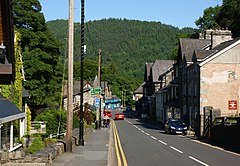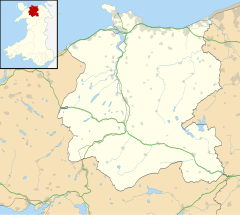Betws-y-Coed
This articleneeds additional citations forverification.(December 2014) |
| Betws-y-coed | |
|---|---|
 A5 trunk roadthrough Betws-y-Coed | |
Location withinConwy | |
| Population | 476 (2011 census)[1] |
| OS grid reference | SH795565 |
| Community |
|
| Principal area | |
| Preserved county | |
| Country | Wales |
| Sovereign state | United Kingdom |
| Post town | BETWS-Y-COED |
| Postcode district | LL24 |
| Dialling code | 01690 |
| Police | North Wales |
| Fire | North Wales |
| Ambulance | Welsh |
| UK Parliament | |
| Senedd Cymru – Welsh Parliament | |
Betws-y-Coed(Welsh:[ˈbɛtʊsəˈkoːɨ̯d];meaning 'prayer-house in the woods') is a village andcommunityin theConwy valleyinConwy County Borough,Wales, located in the historic county ofCaernarfonshire,right on the boundary withDenbighshire,in theGwydir Forest.It is now a very popular visitor destination in theSnowdonia National Park.The population of the community as of the 2021 census was 476, a decline on the previous census.[2][better source needed]
The village has a largevillage greenwhich is bounded on its western side by theA5 trunk road.There are numerous 19th-century buildings, including outdoor clothing shops, hotels, and theChurch of St Mary.
Toponymy[edit]
The name of the village comes from theWelshwordsbetws(a borrowing from theOld Englishbed-hus'a prayer-house' or 'oratory') andy coed('the wood'). The name therefore means 'prayer-house in the wood'. The earliest record of the name isBetusin 1254.[3]
The standard form of the name isBetws-y-coed,rather thanBetws-y-Coed.[4]
History[edit]

The village, which is now within theSnowdonia National Park,stands in a valley near the point where theRiver Llugwyand theRiver Lledrjoin theRiver Conwy.The location is where aCeltic Christiancommunity founded amonasteryin the late 6th century AD. A village developed around the site over subsequent centuries. In the medieval period, the locallead miningindustry brought miners and their families to the village.
Following theActs of Union 1800between Ireland and the UK, better transport links were proposed between the two countries. Surveyors decided that the best route for a road (now the A5) between London andHolyheadshould pass through the village. In 1815,Waterloo Bridge,built byThomas Telford,opened to carry theIrish Mailroad across the River Conwy and through the village. The establishment of the route brought an economic boost to the area as the village became a majormail coachstop betweenCorwen(to the east) andCapel Curig(to the west). It also led to improvement of the roads toBlaenau Ffestiniogand toLlanrwstandConwy.
In 1868Betws-y-Coed railway stationopened with the completion of theConwy Valley line.The railway was built to serve the mineral industries in Blaenau Ffestiniog. With the arrival of the railway fromLlandudno Junction railway station,the village's population increased by around 500 people.
Places of worship[edit]

Church of St Maryis an activeAnglicanparish churchof theChurch in Wales,in the deanery of Arllechwedd, the archdeaconry of Bangor and thediocese of Bangor.[5]It is designated byCadwas a Grade II*listed building.[6]
The Anglican church was constructed to accommodate increasing numbers of summer visitors to the area. It replaced the earlier 14th centurySt Michael's Old Church, from which the village took its nameBetws.The building, which cost £5,000 (equivalent to £560,000 in 2023).[7],was designed by theLancasterpartnership ofPaley and Austin.The principal benefactor was theLiverpoolbusinessman Charles Kurtz. Work began on the village's formercockpitandfairgroundin 1870.
The church wasconsecratedin July 1873. Interior features include a wooden cross-beamed roof with walls and floors made from various types of stone, such as localbluestone,sandstone(floor tiles) fromAncaster,and blackserpentinefromCornwall.There is seating for a congregation of 150 people.[8]
The square bell tower was completed in 1907. An integrated church hall was added in the 1970s; its commemorative stone was laid by theEarl of Ancasterin 1976.
Governance[edit]

There are two tiers of local government covering Betws-y-Coed, atcommunityandcounty boroughlevel: Betws-y-Coed Community Council andConwy County Borough Council.The community council meets at the Memorial Hall on Mill Street (Pentre Felin).[9]
The community, including the village itself and its immediate neighbourhood, has a population of 564.[1]Anelectoral wardof the nameBetws-y-Coedalso exists. This ward includes a large additional area including two neighbouring communitiesCapel CurigandDolwyddelanand has a total population of 1,244.[10]The ward elects a county councillor toConwy County Borough Council.
Administrative history[edit]
Betws-y-Coed was anancient parishin the historic county ofCaernarfonshire.[11]When elected parish and district councils were created in 1894 it was given a parish council and included in theBettws-y-Coed Rural District,which covered the Caernarfonshire parishes from theLlanrwstpoor law union.[12]The parish was converted into anurban districtin 1898.[13]The official spelling of the first part of the name was "Bettws" until 1953 when it was changed to "Betws" to respect modern Welsh orthography.[14]
Betws-y-Coed Urban District was abolished in 1974, with the area instead becoming a community. District-level functions passed toAberconwy Borough Council,which in turn was replaced in 1996 by Conwy County Borough Council.[15][16]
Transport[edit]
Railway[edit]

Betws-y-Coed railway stationis a stop on theConwy Valley line,with passenger services running approximately every three hours each way betweenBlaenau FfestiniogandLlandudno.Services are operated byTransport for Wales.[17]
The station buildings were constructed from local materials by local builderOwen Gethin Jones.[18]The station had double platforms and an extensive goods yard. InLMStimetables, the station was listed asBetws-y-Coed for Capel Curig.
TheConwy Valley Railway Museum,with its extensiveminiature railway,now occupies the former goods yard.

Buses[edit]
Local bus services are operated predominately by Llew Jones Coaches and Gwynfor Coaches. Routes connect the town with Llandudno, Llanberis, Llanrwst and Caernarfon.[19]
Road[edit]
Since the opening of theA5in the early 19th century, the village has been aprimary destinationfor road signage in Snowdonia.
Tourism[edit]
The village is a centre foroutdoor activitiesand lies within theGwydyr Forest.
The current Betws-y-Coed Golf Club was founded in the 1970s. There was an earlier club and course located on or near the Recreation Ground.[20]
TheLlyn Elsireservoirnearby is used by walkers and anglers, and provides water for the village. Footpaths provide access to the lake, both from Betws-y-Coed itself and the outlying village of Pentre Du.
Conwy Valley Railway Museum,with its miniature railway, lies next to the railway station.
Music[edit]
Melys,anindependentrockband,was founded in Betws-y-Coed in 1997. The group, who sing in bothEnglishandWelsh,have recorded eleven sessions forJohn PeelonBBC Radio 1and came first in hisFestive Fiftyin 2001. They wonBest Welsh-language Actat the Welsh Music Awards in 2002.[21]
References[edit]
- ^abUK Census(2011)."Local Area Report – Betws-y-Coed Parish (W04000106)".Nomis.Office for National Statistics.Retrieved4 January2021.
- ^Retrieved 25 February 2024.
- ^Owen, Hywel Wyn; Morgan, Richard (2007).Dictionary of the Place-Names of Wales.Llandysul: Gomer. p. 31.ISBN978-1-84323-901-7.OCLC191731809.
- ^Welsh Language Commissioner."List of Standardised Welsh Place-names".Welsh Language Commissioner.Retrieved2 May2023.
- ^St Mary, Betws-y-coed,Diocese of Bangor,archived fromthe originalon 7 June 2011,retrieved9 June2011
- ^Cadw."St. Mary's Church (3640)".National Historic Assets of Wales.Retrieved11 April2019.
- ^UKRetail Price Indexinflation figures are based on data fromClark, Gregory (2017)."The Annual RPI and Average Earnings for Britain, 1209 to Present (New Series)".MeasuringWorth.Retrieved7 May2024.
- ^Brandwood et al. 2012,pp. 101, 226.
- ^"Memorial Hall".Betws-y-Coed Community Council.Retrieved18 January2024.
- ^UK Census(2011)."Local Area Report – Betws-y-Coed Ward (W05000113)".Nomis.Office for National Statistics.Retrieved4 January2021.
- ^"Betws y Coed Ancient Parish / Civil Parish".A Vision of Britain through Time.GB Historical GIS / University of Portsmouth.Retrieved18 January2024.
- ^Local Government Act 1894
- ^Annual Report of the Local Government Board.1899. p. 316.Retrieved18 January2024.
- ^"'Betws' now - Post Office official ".North Wales Weekly News.Conwy. 13 August 1953. p. 6.Retrieved18 January2024.
- ^Local Government Act 1972
- ^Local Government (Wales) Act 1994
- ^"Timetables".Transport for Wales.May 2023.Retrieved22 August2023.
- ^Jenkins, Robert Thomas."Jones, Owen Gethin".Dictionary of Welsh Biography.National Library of Wales.Retrieved19 January2015.
- ^"Stops in Betws-y-Coed".Bus Times.2023.Retrieved22 August2023.
- ^John Dean."Betws-y-Coed, Conwy".Golfsmissinglinks.co.uk.Retrieved13 December2014.
- ^"Melys - About".Retrieved22 June2021.
- Bibliography
- The A-Z of Betws-y-coed,by Donald Shaw. Gwasg Carreg Gwalch, 1990.ISBN0-86381-153-1
- Brandwood, Geoff; Austin, Tim; Hughes, John; Price, James (2012),The Architecture of Sharpe, Paley and Austin,Swindon:English Heritage,ISBN978-1-84802-049-8
External links[edit]
- Chisholm, Hugh,ed. (1911)..Encyclopædia Britannica.Vol. 3 (11th ed.). Cambridge University Press.
- Betws-y-Coed Community Council official website


